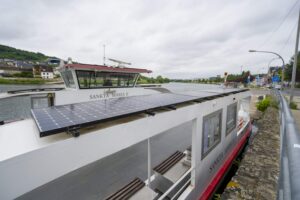The Baltics and “Fit for 55” Green Economies: Offshore Wind, Etc.
Reading Time: 3 minutesWith populations of only 2.79m (Lithuania), 1.92m (Latvia) and 1.32m (Estonia), the Baltic countries are not huge contributors to global emissions. Despite that, they have set out their plans to meet the EU’s “Fit for 55” ambition of reducing greenhouse gas (GHG) emissions by 55% until 2030. This means their economies will undergo a complete transformation through energy efficiency measures, switching to renewable energy, boosting carbon absorption through how land is used, and a revision of emissions trading, among others. It is all supposed to add up to making Europe the first climate-neutral continent by 2050, and according to their plans, the Baltics are stepping up to the challenge.
(Editor’s note: This is the first of three articles on Fit for 55 in the Baltics, featuring policy and developments in Lithuania.)
For one thing, given that all three countries border the Baltic Sea, offshore wind has huge potential for them – some even believe it could turn them into energy exporters. Lukas Trakimavičius of the NATO Energy Security Centre of Excellence recently opined on Euractiv that right now Lithuania, Latvia and Estonia are still quite dependent upon fossil fuels (oil and natural gas). Despite having made some progress, and their massive potential – renewable power makes up only a fraction of these countries’ energy mixes: 2.6% for Lithuania, 4.6% for Latvia and 1.3% for Estonia.
In this regard, there are a number of opportunities for collaboration among the Baltic countries. Latvia and Estonia, for example, are planning a cross-border offshore 1,000 MW wind farm in the Gulf of Riga, but a legal framework for it is still missing. And the costs of such technologies – the wind farms themselves, not to mention the prospect of surplus power used to make “green” hydrogen, need to become more competitive – they are set to come down by 2030, according to the International Renewable Energy Agency.
Lithuania
Europe’s green deal is a key priority for Lithuania, according to prime minister Ingrida Šimonytė, who recently said that her country’s policy initiatives make it possible “to develop more sustainable businesses and to reconcile economic, social, and environmental interests.”
Lithuania is also on board to prioritize a “Fit for 55” set of laws whose aim is to reduce emissions by 55% by 2030. Areas covered by the legislation include renewables, energy efficiency, improving buildings’ energy efficiency, as well as land use, energy taxation, and emissions trading. Its overall budget figure for decarbonization and energy efficiency dimensions totals EUR 7.6 billion over 2021-2030.

According to the country’s draft National Energy and Climate Plan 2021-2030, by 2030 it is aiming for a proposed share of 45% of energy from renewable sources in gross final energy consumption. More specifically, it is looking to achieve 90% for renewable district heating and cooling, 80% for household-based heating and cooling, and 15% for transport using renewable energy. Towards those ends and similar to others’ plans in the Baltic region, Lithuania would like to have at least 700 megawatt (MW) of offshore wind farms in operation by 2030.
Energy efficiency is also in focus, with Lithuania looking to use 1.5 times less energy than the country used in 2018. Digitalizing the country’s electrical infrastructure is also part of its plan, especially when it comes to making energy consumption more efficient. Towards those ends, Lithuania’s electricity and gas distributor, Energijos skirstymo operatorius, will procure and install 1.2 million smart meters for both residential customers who exceed a certain threshold, and for businesses.
Lithuania’s Minister of Energy, Dainius Kreivys, explained: “Our goal is bright and warm homes, and solutions like these motivate consumers to change their habits, to consume energy more efficiently while it motivates suppliers to offer a greater variety of possibilities and services.”
In terms of energy security, policies focus on synchronization with Lithuania’s neighbors, while interconnectivity with others is also crucial for the natural gas sector.
Just last month, Lithuania’s Ministry of Energy said it would prepare national guidelines for the development of hydrogen, followed by a public tender. Hydrogen will be considered towards decarbonization of Lithuania’s industrial, transport, energy and building sectors, according to energy minister Kreivys. The Baltic countries are seen as potential “green hydrogen” producers, given that excess renewable power could be used to create hydrogen, which could be stored and transported through existing natural gas infrastructure. Still, an expert analysis of the entire hydrogen value chain, from production through to infrastructure adaptation, needs to take place.
In its evaluation of Lithuania’s National Energy and Climate Plan, the European Commission pointed out the need for Lithuania to integrate social and employment aspects into its plan for a green transition as well as evaluating energy subsidies for fossil fuels.

